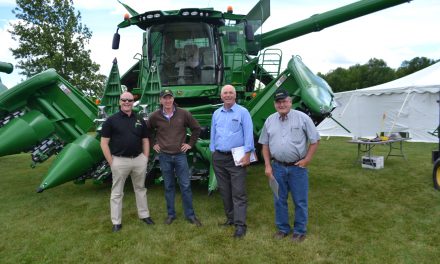by Jakob Vogel, B.Sc. Agr.
Dairy Consultant
In recent years, a rising trend to be discussed on dairy farms is forage quality, and how maximizing forage quality will not only maximize dry matter intake, but more importantly drive milk production at lower purchased feed costs. As an industry, I think we are doing a pretty good job – but still have some opportunity to improve feed efficiency, and milk production from good quality forages.
So what makes a good quality forage?
Of course, there is the infamous “crude protein” which naturally is important when looking at the costs associated with purchased protein supplements. Forage analysis is a complex management tool that need to be reviewed often to make sure that other quality factors such as digestibility, energy, ADF, NDF and the fermentation profile is adequate and a well-balanced diet is constructed from those forages.
While there are visual cues that would indicate a poor quality forage – such as moulds, smells and heating, there are invisible hindrances that can be measured with a forage sample. In addition to these forage samples, we should also be taking advantage of Toxin Screening, which allow us to measure and quantify these invisible pests within our forages.
Before moving to the “how do we fix it” portion, it is important to understand what a toxin is and where they stem from. Contrary to popular belief, toxins in feed, more specifically “Mycotoxins” are not bacteria or a living organism at all. They are actually metabolic byproducts from fungi that may present itself on many forage crops. To be more specific, most toxins actually stem from fusarium species, the same species of fusarium that contaminated wheat fields can contaminate forage crops as well.
The most difficult part of managing toxin loads, is to prevent rather than try and cure – which is much easier said than done. With an understanding of where these toxins originate from, there are a couple of management points that quickly spring to mind when trying to manage a toxin problem on the farm before the feed is harvested and ensiled. Off the bat, some calls need to be made – especially to your agronomist (Certified Crop Advisors) and your nutritionist.
The role of the Agronomist (CCA) would be to hopefully recommend fungicide application rates and which chemicals (or biological counterparts) can be used to control and reduce the likelihood of infection without compromising yields and end quality of the stand.
The nutritionist should be playing multiple parts. The first would be determining which toxins are the biggest problems on farms, because with different families, origins and biochemistry, the recommendations to follow can be quite different. The second, in the hope of preventing infections would typically make recommendations to cutting height (hay or haylage crops) and necessary adjustments to the harvesting equipment to reduce ash content (soil contamination) which can be a great environment for fungi to stem from. Finally, if the silage is already in the silo, the use of an appropriate anti-toxin is typically recommended.
How do we know which toxins to test without becoming completely overwhelmed? In our area, we are quite susceptible to 3 main families of toxins; Vomitoxin (DON), Zearalenone and T2/H2. As earlier mentioned, there are hundreds of families, most of which can be analyzed by specialized laboratories. However, for the simplicity of things – start by looking for the common three mentioned above.
There are many products that are usable as anti-toxins on the market. The key is to make sure that the product being used on farm is the more efficient one for your situation. There are products that have, over time, been used as a blanket treatment for any toxin problem on farm – which, although they will have an impact on adsorbing some of the pressure within the cow, we need to dig further into the composition of these different toxins and how we combat them the most.
With the ever increasing knowledge that we have on toxins and the links that they can have on dry matter intake, reproduction, immunity (liver function), successful transition, etc.; the use of toxin binders can no longer be considered an additional cost but rather an investment in your cow’s health. Additionally, depending on the nature of the problem and the impact it’s having on farms; a more in-depth meeting with your consultant/management team would be worthwhile!












